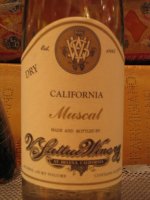 |
|
Wine Details
Price:
$16.95 per bottle
Description:
Another wine that sold out before Christmas, our Dry Muscat, fresh from the 2005 vintage, has gained quite a following, and quickly. We use the seductive Muscat of Alexandria grape, but make it in a drier, crisper style, similar to our Dry Riesling, and one that welcomes pairing with many foods, including seafood, poultry and veal.
|
|
Varietal Definition
Muscat:
Muscat, thought to be one of the oldest grape varieties, is grown worldwide. It is vinified in a multitude of styles, from still to sparkling, and dry to sweet to fortified. Also called Moscato, Moscatel and Muskateller, it is a sweetly aromatic, fruity grape that has many genetic variations and colors. It probably originated in Greece but maybe the independent sultanate of Muscat in the southeast of the Arabian Peninsula had something to do with it. Over 200 different varieties and derivatives to the Muscat family exist today. Muscat Canelli, Orange Muscat and Black Muscat are varieties most planted in California, which makes primarily still wine. More unusual is Muscat fermented to total dryness, which leaves greater alcohol levels and no residual sugar. Some Muscats are aged in oak to provide additional complexity.Today’s recommended Muscats represent many of these styles, so use the tasting notes and percent of residual sugar - listed if provided by the winery - to find a wine you’ll enjoy. The more sugar and the lower the alcohol, the sweeter the wine, though wines above 10 percent alcohol can also be somewhat sweet.
|
Muscat of Alexandria:
(aka Muscat Gordo Blanco or Lexia in Australia and Hanepoot in South Africa). Ancient grape species suitable for similar Mediterranean growing climates as the Muscat Blanc above. Makes sweet wines that are usually judged of inferior quality compared to those of the Muscat Blanc cepage varieties. The main use in California is for producing raisins. Also widely grown in Spain, where it is called Moscatel de Alejandria, and Portugal where winemakers in the latter country use it to make "Moscatel de Setubal" sweet wine.
|
Riesling:
On the sweeter end of the spectrum, some of the best dessert wines should give thanks to the Riesling varietal. Riesling is known for its complementary nature of combining balanced acidity with sugar. Rieslings are made dry to sweet, but it is the sweet style Riesling that brought about its popularity in the United States. With the rise of spicy sauces, marinades and dips to flavor our meal, Riesling plays a part in taking off the edge of the heat. Riesling is known for a number of signature characteristics: floral, citrus and pear. Riesling has peaked in California with 11,000 acres planted. Today, Monterey County’s cool-climate areas and its long growing season produce good amounts of character for the Riesling grape. Outside of
|
|